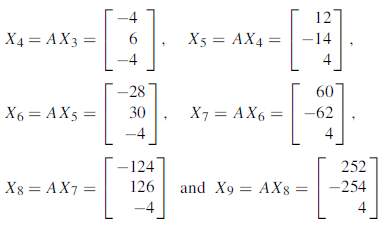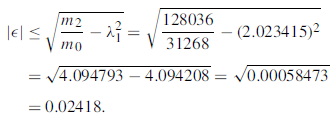Unit-5
Boundary value problems
Q1) Solve the boundary value problem defined by

by finite difference method. Compare the solution at y (0.5) by taking h=0.5 and h=0.25.
A1) Given equation 
With boundary condition 
By finite difference method
 …. (iii)
…. (iii)
Putting(iii) in (i) we get
 …. (iv)
…. (iv)
For h=0.5, here for  which corresponds to
which corresponds to 
For i=1 in equation (iv) we get




For h=0.25, here 
Which corresponds to 
For i=1 in equation (iv) we get



For i=2 in equation (iv) we get



For i=3 in equation (iv) we get



From equation (v), (vi) and (vii) we get



On solving above triangular equation we get

Hence for h=0.5 we get y (0.5) =0.44444
And for h=0.25 we get y (0.5) =0.443674
Q2) Solve the bounded value problem

With boundary condition 
A2) Given equation

With 
By finite difference method
 …. (3)
…. (3)
Putting (3) in equation (1) we have
By finite difference method
 …… (4)
…… (4)
Let h=1, we have 
Corresponds to 
For i=1 in equation (4) we get



For i=2 in equation (4) we get



For i=3 in equation (4) we get



From equation (5), (6) and (7) we get



On solving we get 
Q3) Solve the boundary value problem

With y (0) =0 and y (2) =3.62686
A3) Given equation  …. (1)
…. (1)
With boundary condition y (0) =0 and y (2) =3.62686…. (2)
By finite difference method
 …. (3)
…. (3)
Substituting (3) in equation (1) we get
 …. (3)
…. (3)
Let h=0.5 then for 
Which corresponds to 
For i=1 in equation (3) we get



For i=2 in equation (3) we get



For i=3 in equation (3) we get



From equation (4), (5) and (6) we get



On solving we get 
Q4) Explain how do we find the smallest Eigen value.
A4) If  is the Eigen value of A, then the reciprocal
is the Eigen value of A, then the reciprocal  is the Eigen value of
is the Eigen value of  , then the reciprocal of the largest Eigen value of
, then the reciprocal of the largest Eigen value of  will be the smallest Eigen value of A.
will be the smallest Eigen value of A.
Q5) Explain power method.
A5) Procedure for Power method-
Step-1: First we choose an arbitrary real vector  , basically
, basically  is chosen as-
is chosen as-

Step-2: Compute  ,
,  ,
,  ,
,  , …………
, ………… Put
Put 
Step-3: compute  ,
,  ,
, 
Step-4: The largest Eigen value is

The error in  can be find as-
can be find as-

The Eigen vector corresponding to  is
is 
Q6) Find the largest Eigen value and the corresponding Eigen vector of the matrix

Also find the error in the value of the largest Eigen value.
A6)
Let us choose the initial vector

Then



Now put  , then-
, then-

Hence the largest Eigen value is-


And the corresponding Eigen vector is-

The error can be calculated as-

Q7) Give the classification of PDE’s.
A7) The general linear PDE of the second order in two independent variables is of the form-

Then there are three conditions-



Q8) Classify the equation-

A8) Here A = 
Now

That means,
The equation is hyperbolic.
Q9) Classify the equation 
A9) Here 

Hence the equation is parabolic
Q10) Solve the Laplace’s equation  in the domain
in the domain

A10) The initial values using five diagonal formula we have
Here  ,
, 





The remaining quantities are calculated by using standard five-point diagonal formulas.




Hence  and
and  .
.
Q11) Solve the Laplace’s equation for

A11) The initial values using five diagonal formula we have
Here  ,
, 





The remaining quantities are calculated by using standard five-point diagonal formulas.




Hence  and
and  .
.
Q12) Solve the elliptical equation for

A12) The initial values using five diagonal formula we have
Here  ,
, 





The remaining quantities are calculated by using standard five-point diagonal formulas.




The Above is symmetric about PQ, so that  .
.
We will have iteration process using the Gauss Seidal Formula







First iteration: Putting  we get
we get







Second Iteration: Putting  , we get
, we get






Third Iteration: Putting  , we get
, we get






Fourth Iteration: Putting  , we get
, we get






Fifth iteration: Putting n=4 we get





 .
.
Q13) Solve the Poisson equation


A13) Let the point be defined by  At the point A,
At the point A,  . The standard five-point formula at point A is
. The standard five-point formula at point A is

Or 
Or  ….(i)
….(i)
Again, the standard five-point formula at the point B is

Or 
Or  ….(ii)
….(ii)
Similarly, the standard five-point formula at the point C

Or 
Or  …. (iii)
…. (iii)
Similarly, the standard five-point formula at the point D

Or 
Or  …. (iv)
…. (iv)
From (ii) and (iii) we get  =
= . Hence the iteration formula we have
. Hence the iteration formula we have


 .
.
First iteration: Putting  . Hence, we obtain
. Hence, we obtain



Second iteration: Putting n=1, we get



Third iteration: Putting n=2, we get



Fourth iteration: Putting n=3, we get



Fifth iteration: Putting n=4, we get



Sixth iteration: Putting n=5, we get



Since last two iteration are approximately equal, hence
 .
.
Q14) Solve the equation  with the conditions
with the conditions  . Assume
. Assume . Tabulate u for
. Tabulate u for  choosing appropriate value of k?
choosing appropriate value of k?
A14) Here  and let
and let  ,
,
Since 

 The Bendre-Schmidt recurrence formula we have
The Bendre-Schmidt recurrence formula we have
 …. (i)
…. (i)
Also given  .
.
 for all values of j, i.e., the entries in the first and the last columns are zero.
for all values of j, i.e., the entries in the first and the last columns are zero.
Since 
 (Using
(Using 
For  .
.
Putting 

Putting  successively we get
successively we get









These will give the entries in the second row.
Putting  in equation (i), we will get the entries of the third row.
in equation (i), we will get the entries of the third row.

Similarly,  successively in (i), the entries of the fourth rows are
successively in (i), the entries of the fourth rows are
obtained.

Hence the values of  are as given in the below the table:
are as given in the below the table:
| 0 | 1 | 2 | 3 | 4 | 5 | 6 | 7 | 8 | 9 | 10 |
0 | 0 | 0.09 | 0.16 | 0.21 | 0.24 | 0.25 | 0.24 | 0.21 | 0.16 | 0.09 | 0 |
1 | 0 | 0.08 | 0.15 | 0.20 | 0.23 | 0.24 | 0.23 | 0.20 | 0.15 | 0.08 | 0 |
2 | 0 | 0.075 | 0.14 | 0.19 | 0.22 | 0.23 | 0.22 | 0.19 | 0.14 | 0.075 | 0 |
3 | 0 | 0.07 | 0.133 | 0.18 | 0.21 | 0.22 | 0.21 | 0.18 | 0.133 | 0.07 | 0 |
Q15) Solve the heat equation

Subject to the conditions  and
and

 .
.
A15) Take  and k according to Bendre-Schmidt equation.
and k according to Bendre-Schmidt equation.
Here  and let
and let  ,
,
Since 

 The Bendre-Schmidt recurrence formula we have
The Bendre-Schmidt recurrence formula we have
 …. (i)
…. (i)
Also given  .
.
 for all values of j, i.e., the entries in the first and the last columns are zero.
for all values of j, i.e., the entries in the first and the last columns are zero.
Since 
 .
.

 .
.

For 
Putting 

Putting  successively we get
successively we get



These will give the entries in the second row.
Putting  in equation (i), we will get the entries of the third row.
in equation (i), we will get the entries of the third row.

Similarly,  successively in (i), the entries of the fourth rows are
successively in (i), the entries of the fourth rows are
obtained.

Hence the values of  are as given in the below the table:
are as given in the below the table:
| 0 | 1 | 2 | 3 | 4 |
0 | 0 | 0.5 | 1 | 0.5 | 0 |
1 | 0 | 0.5 | 0.5 | 0.5 | 0 |
2 | 0 | 0.25 | 0.5 | 0.25 | 0 |
3 | 0 | 0.25 | 0.25 | 0.25 | 0 |
Q16) Use the Bendre-Schmidt formula to solve the heat conduction problem
 With the condition
With the condition  and
and  .
.
A16) Let  we see
we see  when
when  .
.
The initial condition is  .
.
Also  .
.
The iteration formula is
 =
=
First iteration: Putting n=0, we get



Second iteration: Putting n=1, we get



Third Iteration: putting n=3, we get



Fourth Iteration: putting n=3, we get



Fifth Iteration: putting n=4, we get



Hence the approximate solution is 

